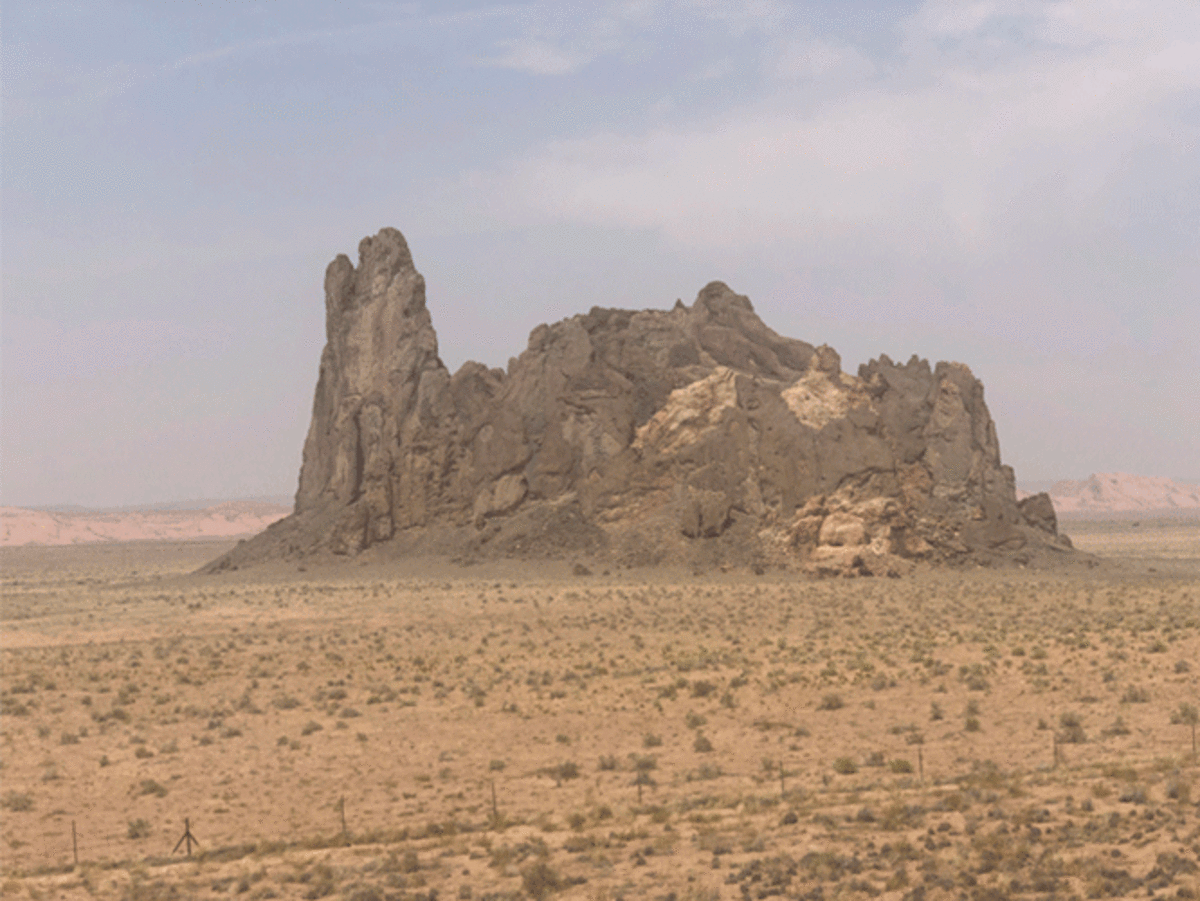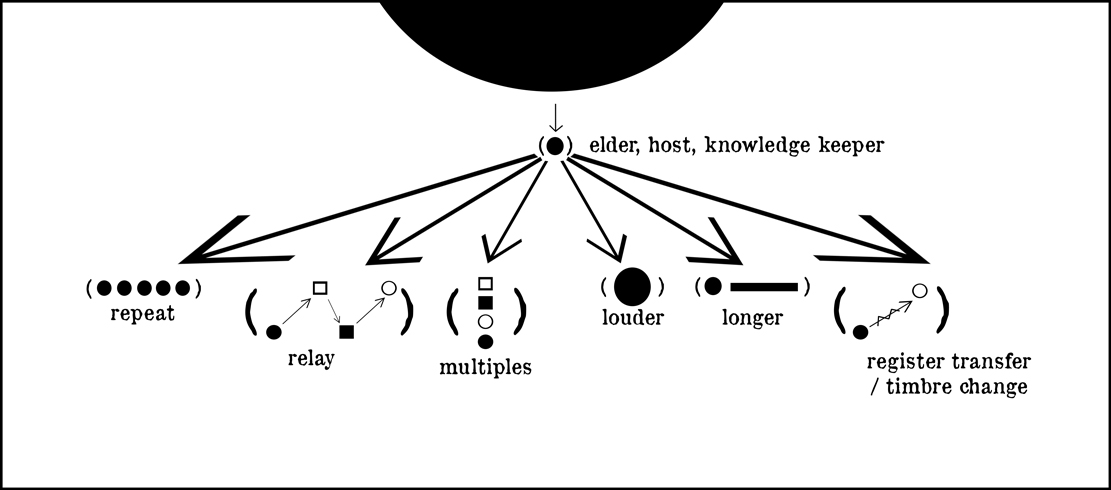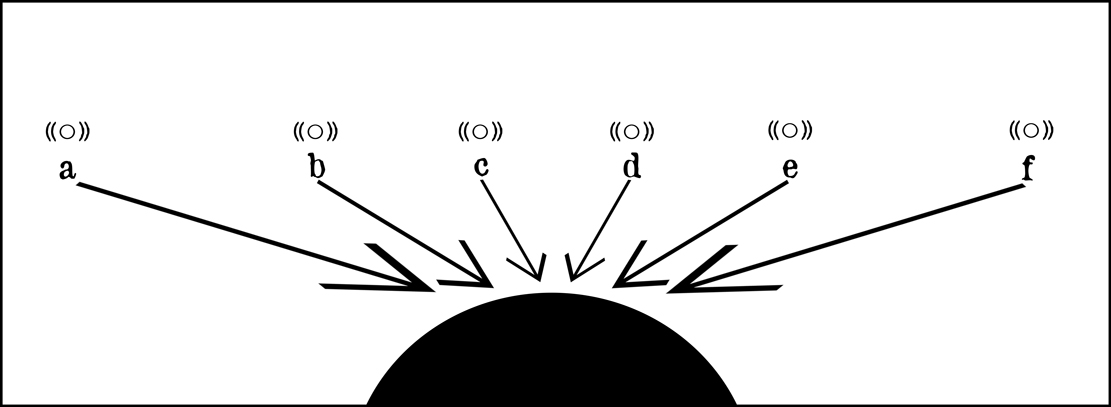Dispatch
Candice Hopkins and Raven Chacon
Honolulu Premiere
April 7, 2023, 3 PM
Campus Center Steps
University of Hawaiʻi at Mānoa
Dispatch is a conceptual score conceived collaboratively by Navajo Nation composer Raven Chacon and Carcross/Tagish curator and writer Candice Hopkins. Published in three parts — or ‘Dispatches’ as the artists declare — the work draws from Chacon and Hopkins’ reflections on the fight for cultural preservation and defense of Indigenous sovereignty at the Standing Rock Reservation Water Protector encampment in 2016.
Dispatch is either a transcription of events around the 2016 DAPL encroachment at Standing Rock, a prompt for an ecological oral future, or at the very least, a critique of the privilege of meditative Deep Listening. This score can be realized as a performance or as a series of imagined events. It can also be enacted in the real world. The players, the prompts, and the schematics are derived from an analysis of the surface dynamics and organization of the Water Protectors in defense of Standing Rock during the #noDAPL movement, not glossing over the miscommunication, profiteering, and injustices. In an increasingly fractured society, new paths and new formations are needed to refocus our attention in an attempt to find truth. Participating in this score may produce sonic or visual artifacts, these are as important as the actions.
Raven Chacon
November 2020
Program
- Welcome from the Ethnic Studies Department
- Oli: "Welina Mānoa" by Keawe Lopes chanted by ʻIhi Lasconia
- Greeting: from Skayu Louis
- Introduction of Candice Hopkins by Ruby Aliason
- Introduction of Raven Chacon by Kyle Help
- Introduction of the performers Ruby Aliason: Candice Hopkins and Raven Chacon, with Liko Martin, Laulani Teale, Mari Matsuda, Lelemia Irvine, Oʻahu Intertribal Council Dancers, and ʻIhi Lasconia
Dispatch: Score
Dispatch 1: The Call
This rock is under threat.
We need to gather here to protect it.
Our actions begin and end at this place.

Players
- Hosts: People who live and have lived here for centuries.
- Spiritual Leaders: Indigenous people from any tribe or nation.
- Front Line Activists: (Native and non) ready and willing to engage directly with police, militia, or construction crews.
- Militant Indigenous People: Group of their own. Willing to engage in direct action. Not necessarily in collaboration with front line activists or the hosts.
- Narcs: (Native and non) undercover police. Any one participant can be a narc.
- Reporters: Chronicle for those outside the grounds (as well as inside the grounds).
- Politicians: Bring attention. Appear to be listeners. Also there for face time.
- Counter-Surveilers: To surveil the police and encroachers.
- Helpers*: (Native and non) bring supplies, food, or a necessary skill. Stay out of the way. Take minimal space and resources.
- Witnesses*: Listen and observe.
- Artists: Engage in creativity, but also self-agenda/promotion. Have the potential to aid the camp in forming its identity. Their artwork can use up resources (water, heat, electricity).
- Gatekeepers: Maintain the entrance to the camp. Vet those who enter. A host or trusted by the hosts.
- Temporary Campers/Sympathisers: Bring attention to the cause, temporarily. Cannot or do not know how to belong to the camp.
- Others: Tourists, those without a home, others.
*At a minimum, participants should join with the intent of taking the role of a witness or helper.
Dispatch 2: The Gathering
Rocks have harmonics, resonant frequencies. They are also deities, lives begun millions of years ago, witnesses to the formation of the earth. They can pick up the tremors of extractive colonialism exposing wide caverns that lead to trails deep inside the ground, generating sludge and slurry, releasing poisons meant to stay undisturbed. The time is now to protect these rocks as though it is a last stand. Our gathering can open up the way to other worlds, those of our own making. These other worlds are not de-colonial ones, but non-colonial ones. Not bound by their frameworks, but by ours. Heeding this call is the first action. In this action we come together, in-person or at a distance, to open up a portal of shared experiences.

Schematic 1
Prompts: Set 1
Choose one or more prompts to follow
(Consider the prompts as protocols—of relation, of listening, of action, of witnessing, of performing)
Schematic 1 can be used as an aid in engaging with others in the camp.
- Heed the call
- Hosts determine points of reference
- If you are not already there, arrive
- Gatekeepers welcome and relay protocols of place
- Do nothing (activated at any time)
- Listen (ongoing)
- Listen beyond (to your immediate surroundings, to the land or water, to sounds outside your normal range)
- Sustain yourself (don’t be in the way, don’t encroach); at the same time, be useful (observe; introduce yourself, unobtrusively; deliver supplies; find your place; determine your role, humbly)
- Broadcast outward (for any player at any time). Also determine what is not to be shared
- Create a small gathering (5 people or less) for one activity. Do something—cook; pray; sing; teach a game
- If necessary, initiate a larger gathering
- Witness, relay what you learned
- Translate a broadcast for other listeners—consider different languages, different tones
This score can be realised as a performance or as a series of imagined events. It can also be enacted in the real world. The players, the prompts, and the schematics are derived from an analysis of the dynamics and organisation of the Water Protectors in defense of Standing Rock during the noDAPL movement, not glossing over the miscommunication, profiteering, and injustices. In an increasingly fractured society, new paths and new formations are needed to refocus our attention in an attempt to find truth. Participating in this score may produce sonic or visual artifacts, these are as important as the actions.
Dispatch 3: The Aim
After realising the prompts in Set 1, consider the following:
What does the land need?
What do the hosts want?
Do you belong here?
Who do you look to for guidance?
What are your skills/strengths?
What are the threats?
Who do you trust?
What are you willing to risk?
Who is in charge?
What is the model of leadership?
How do we maintain focus?
Prompts: Set 2
Choose one path to get back to the rock (with clear aim, do not waver)
Schematic 2 can be used as an aid to trace six possible paths back to the rock
a. Establish the protocols necessary for the next defence
b. Amplify the call
c. Gather the players (new or existing), establish their roles
d. Determine the parameters of ally-ship (with people, with the land)
e. Move to another site needing protection. Continue your actions here
f. Together, define your actions. Maintaining the camp, defending the rock, and so on

Schematic 2
Coda
In 2016, a delegation of five women, Dr. Sarah Jumping Eagle; Wasté Win Young; Tara Houska; Autumn Chacon; and Michelle Cook, on behalf of Water Protectors during #noDAPL, continued their activism elsewhere as a way to further erode the links between extractive colonialism and capitalism. By uncovering the funders of the pipeline (from banks to private corporations), they made a public call for them to divest. In March, 2017, they travelled to Norway and Switzerland to meet with banking personnel to explain how their investments were directly impacting the lives of American Indian people—particularly women and children—polluting water and degrading land in a violation of Indigenous rights. The Norwegian bank, DNB, decided to completely divest, others have yet to heed their call.
Candice Hopkins is a curator, writer and researcher interested in history, art and indigeneity, and their intersections. Originally from Whitehorse, Yukon Territory, Hopkins is a citizen of Carcross/Tagish First Nation. She was senior curator for the 2019 Toronto Biennial of Art, and worked on the curatorial teams for the Canadian Pavilion at the 58th Venice Biennale, and documenta 14.
Raven Chacon is a composer, performer and artist from Fort Defiance, Navajo Nation. His work ranges from chamber music to experimental noise, to large scale installations, produced solo and with the Indigenous art collective Postcommodity. At California Institute of the Arts, Chacon studied with James Tenney, Morton Subotnick, Michael Pisaro and Wadada Leo Smith developing a compositional language steeped in both the modernist avant-garde and Indigenous cosmologies and subjectivities. He has written for ensembles, musicians and non-musicians, and for social and educational situations, and toured the world as a noise artist.
ACKNOWLEDGEMENTS
Candice Hopkins and Raven Chacon: Dispatch is published as part of Unsettling Scores, a series curated by Liquid Architecture for Monash University Museum of Art in conjunction with the exhibition Samson Young: Real Music.
Bringing together artists, musicians and writers from around the world, the series examines how experimental and political sound and acts of listening — grounded in the language of musical scores — become vehicles of unsettlement, disrupting logics of settlerism, extractivism, expropriation, and appropriation, while at the same time offering powerful assertions of sovereignty, resistance, and futurity.